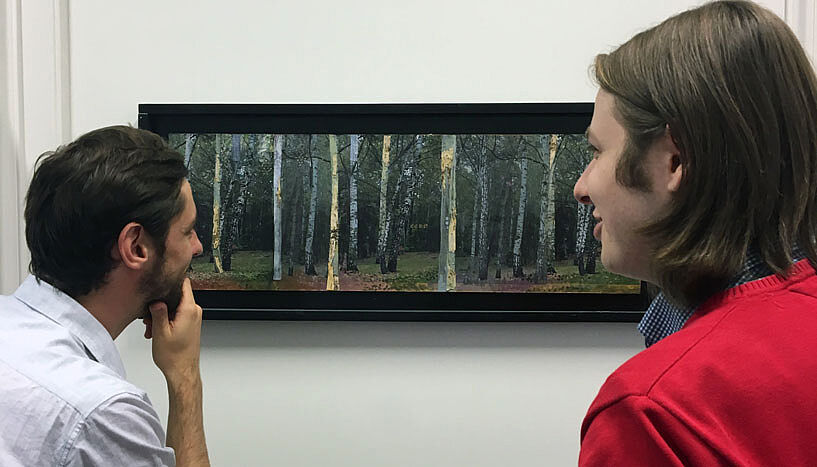We like what experts like - and what is expensive
30. November 2016
Matthew Pelowski (left) and Michael Forster (right) from the Faculty of Psychology at the University of Vienna during the research for their study. The picture was made by Department-Head Helmut Leder, (Copyright: Kürgen Goller).
Art taste bends to social factors
Whether Peter Paul Rubens or Damien Hirst – the personal taste of art can be argued. Scientists from the Faculty of Psychology of the University of Vienna have now shown that the individual taste of art is also dependent on social factors. The personal valuation of art was influenced by who else liked the work - or not. And even the value of a painting strengthened the subjective feeling of how much a work of art appeals to us. The study was recently published in the international journal "Psychology of Aesthetics, Creativity and the Arts".
Together with colleagues from the University of Copenhagen, Matthew Pelowski and Michael Forster from the Department of Basic Psychological Research and Research Methods at the University of Vienna have observed the influence of social and financial contextual information on the pleasures of art. The focus was on the question whether the purchase price, the prestige of a gallery or the socioeconomic status and educational status of other persons have an influence on the personal taste.
We like what experts or peers like - and what is expensive
During the study, students assessed a series of paintings according to personal pleasure. Before the presentation, the participants learned that certain social groups had already seen and evaluated the works before them. These included either peers (fellow university students), experts (museum curators at respected museums), or a group of similarly aged university dropouts who were currently unemployed and long-time social security recipients. The results were then compared with a control group that had evaluated the images without social context information.
"Results showed that when participants thought that either experts or their peers liked a painting, they also liked it more", says Pelowski. "However, when they thought that the unemployed dropouts didn’t like a painting, participants went in the opposite direction and said that they liked it more."
In a second study, the researchers also showed that telling participants the (fictitious) sales price of a painting at an art auction, significantly changed the way they rated art. Very low prices made participants like art less, very high prices made them like art more.
Art is used to show allegiance to desirable social groups
"These results provide empirical support for a 'social distinction' theory, first introduced by the French Sociologist and Philosopher Pierre Bourdieu," explains Pelowski. "According to how we use our evaluation and engagement with art in order to show allegiance to, or distance ourselves from, desirable or undesirable social groups." Both studies also have important implications for museums, suggesting that the context can affect how we see art.
Publication in "Psychology of Aesthetics, Creativity and the Arts":
Lauring, J. O., Pelowski, M., Forster, M., Gondan, M., Ptito, M., & Kupers, R. (2016, June 13). Well, if They Like it . . . Effects of Social Groups’ Ratings and Price Information on the Appreciation of Art. Psychology of Aesthetics, Creativity, and the Arts. Advance online publication.
DOI: http://dx.doi.org/10.1037/aca0000063
Wissenschaftlicher Kontakt
Dr. Michael Forster
Institut für psychologische Grundlagenforschung und ForschungsmethodenUniversität Wien
1010 - Wien, Liebiggasse 5
+43-1-4277-471 61
michael.forster@univie.ac.at
Dr. Matthew Pelowski
Department of Cognition, Emotion, and Methods in PsychologyUniversity of Vienna
1010 - Wien, Wächtergasse
+43-1-4277-47112
matthew.pelowski@univie.ac.at
Rückfragehinweis
Stephan Brodicky
Pressebüro der Universität WienUniversität Wien
1010 - Wien, Universitätsring 1
+43-1-4277-175 41
+43-664-60277-175 41
stephan.brodicky@univie.ac.at
Downloads:
social_priming_press_release_photo.jpg
Dateigröße: 3,42 MB
